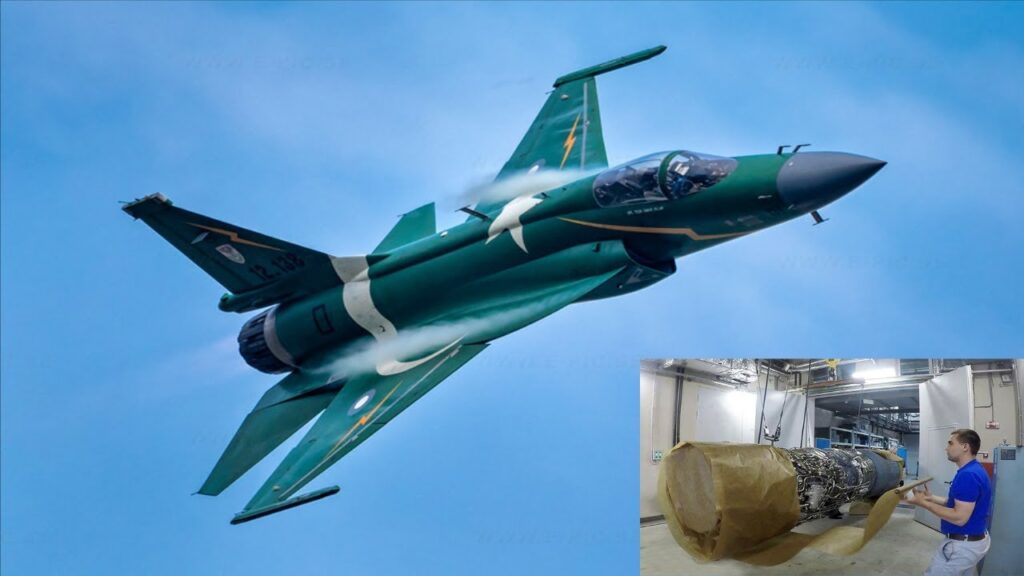By Major (R) Haroon Rasheed – Defence & Strategic Analyst
In the evolving dynamics of modern air warfare, the key to air dominance lies not only in design or avionics—but in the engine that powers the platform. For Pakistan’s JF-17 Thunder Block III, the integration of the RD-93MA engine marks a defining leap forward, transforming the aircraft into a credible 4.5 generation fighter—agile, networked, and war-ready
The RD-93MA is not just an upgrade; it is an enabler—one that allows the JF-17 Block III to close the gap with much more expensive aircraft like the Rafale, F-16 Block 70, and even challenge emerging regional fifth-gen threats.
Flight Catches Fire Before Takeoff, Pilot Sends ‘Mayday’ Call To ATC
US Confirms Pak’s visit to Washington for bilateral meet
Indian Visas For Chinese Tourists From Tomorrow, After 5-Year Gap
For more such Opinions & Blogs, click here.
RD-93MA Engine: The Heart of Block III
Developed by Russia’s Klimov Design Bureau, the RD-93MA is an improved variant of the RD-93 turbofan engine used in earlier JF-17 variants. This advanced engine delivers:
Higher Thrust Output: Over 100 kN, enabling faster acceleration, sharper climb rates, and sustained high-altitude performance.
Greater Electrical Output: 45–50 kW, providing the power needed for modern systems like AESA radar, IRST, EW pods, and helmet-mounted sights.
Digital FADEC (Full Authority Digital Engine Control): Enabling smoother flight performance, fuel efficiency, and fault diagnostics.
Improved Maintenance Profile & Service Life: Designed for extended missions and high-sortie cycles.
This engine is the critical backbone allowing the JF-17 Block III to perform like a modern multirole fighter—efficiently, aggressively, and reliably.
What RD-93MA Enables in the JF-17 Block III
With this engine, the JF-17 Block III is no longer a budget fighter—it is a digitally enhanced, fully networked 4.5-gen platform. The engine supports:
KLJ-7A AESA Radar with long-range target tracking and multiple engagement capability
Helmet Mounted Display (HMD) for high-off boresight missile targeting
Infrared Search and Track (IRST) for stealth and passive detection
Electronic Warfare (EW) Systems and datalink for network-centric warfare
Increased payload capacity exceeding 4,500 kg
The aircraft now features 7+ hardpoints, carrying a mix of:
PL-10 (short-range, HMD-guided)
PL-15 / PL-17 (BVR missiles, 200–250 km range)
Potential integration of PL-21, a next-gen hypersonic BVR missile
Families Of 2 Air India Crash Victims In UK Claim Received Wrong Bodies
AT UNSC, Pakistani diplomat hits back at India for accusing Pakistan of cross-border terrorism
Improving tax system Govt’s top priority: PM
RD-93MA + Avionics = Strategic Superiority
The additional 50kW power provided by RD-93MA makes it possible for JF-17 Block III to:
Match and, in some aspects, outperform aircraft like the F-16 Block 70 or Rafale, especially in BVR combat
Operate next-gen sensors and weapons simultaneously
Run complex mission software and defensive systems without overloading
Battle-Tested: Validated in Operations Swift Retort & Bunyanoon Marsoos
Though the article’s focus is on the engine, it’s important to note that May 2025’s Operation Bunyanoon Marsoos was the first real-world combat deployment of the RD-93MA-powered JF-17 Block III.
The aircraft was used in interception, precision strike, and deterrence roles against Indian incursions during Operation Sindoor.
At least one Indian Jaguar was confirmed shot down, with reports suggesting possible engagement with a Rafale, validating both the aircraft’s radar and engine performance under real-world pressure.
World Whale and Dolphin Day being observed today
PM condoles over death of former Punjab Governor Mian Azhar
Veteran Politician and Former Punjab Governor Mian Azhar passes away
Performance at a Fraction of the Cost
The RD-93MA gives JF-17 Block III an edge not just in combat—but in sustainability:
Comparison JF-17 Block III Rafale / F-16 Block 70
Unit Cost $25–30 million $80–100+ million
Operating Cost ~1/3 of Western jets High (complex systems)
Engine Maintenance Local + Chinese support High-cost OEM dependency
Tech Sovereignty Yes (PAC Kamra) No (subject to sanctions/export law)
This makes the platform ideal for countries looking to modernize air fleets without breaking the treasury.
Conclusion
RD-93MA Makes JF-17 a Strategic Equalizer
The integration of the RD-93MA engine in the JF-17 Block III has redefined what a mid-weight fighter can achieve. It unlocks true 4.5 generation capability—combining firepower, digital sophistication, affordability, and now, combat experience.
For Pakistan and its allies, this is not just an engine upgrade. It is proof that indigenous and allied innovation can match Western dominance—without being dependent on it.
For more such Opinions & Blogs, click here.
IAF to conduct major exercise in Rajasthan from July 23
World Jr Squash C’ship : Nawaz beats China’s Kang Leung 3-0
Rawal Dam spillways opened as water level rises after heavy rains
Four more terrorists of Fitna al Hindustan neutralized in Kalat
Pakistan Army launches rescue operation for stranded tourists in Babusar
Major (R) Haroon Rasheed is a retired officer of the Pakistan Army and a defense analyst focusing on South Asian strategic affairs and emerging military technologies.
Stay tuned to Baaghi TV for more. Download our app for the latest news, updates & interesting content!






